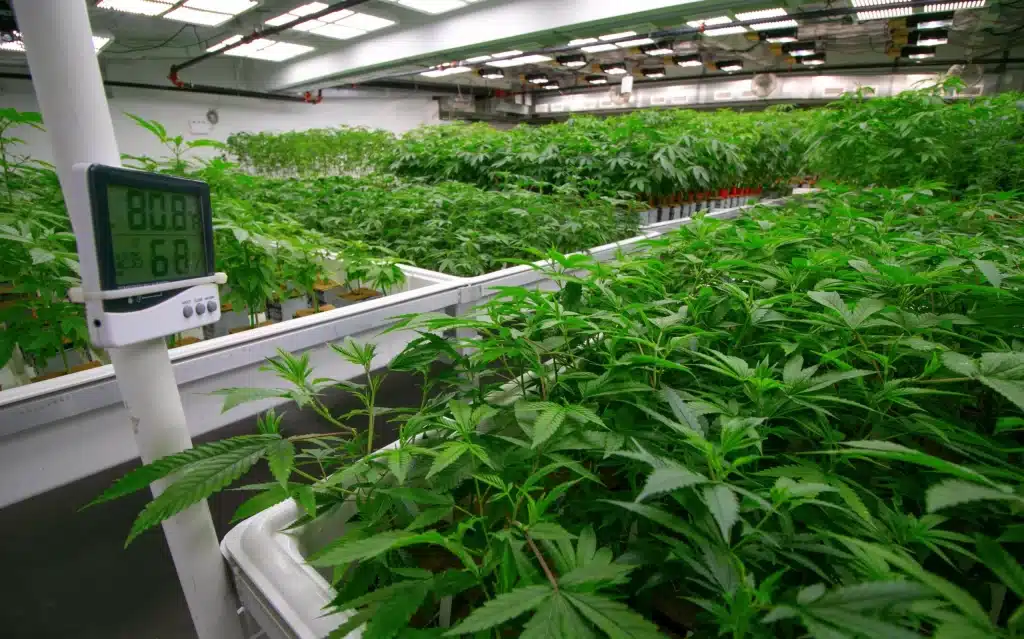Blog
The Critical Role of Humidity Levels
Cannabis cultivation is a delicate and intricate process that requires growers to consider various factors that can affect plant growth and yield. One such crucial factor is humidity. Humidity levels play a vital role in cannabis growth, affecting plant transpiration, nutrient uptake, and even the risk of pests and diseases. In this blog, we will explore the impact of humidity levels on cannabis plant growth, the risks of high humidity, and how to maintain optimal levels throughout the growth cycle.
The Relationship Between Humidity and Transpiration
Humidity levels and plant transpiration are closely related, and maintaining the right balance is crucial for healthy cannabis growth. When humidity levels are too high, the air becomes saturated with moisture, making it difficult for water to evaporate from the leaves. As a result, transpiration slows down, and the plant takes in less water and nutrients from the soil. This can ultimately lead to stunted growth and reduced yields. On the other hand, when humidity levels are too low, the air becomes dry, and transpiration speeds up, causing the plant to lose water rapidly. This can lead to water stress, where the plant cannot take in enough water to support its growth, ultimately leading to wilted leaves and stunted growth. Therefore, maintaining optimal humidity levels throughout the growth cycle is essential for proper transpiration, nutrient uptake, and overall plant health.
The Risks of High Humidity
High humidity levels can pose significant risks to cannabis cultivation. One of the most significant risks of high humidity levels is the increased likelihood of pests and diseases. Mold, mildew, and spider mites thrive in warm and humid conditions, and high humidity levels can create an ideal breeding ground for these organisms. Mold and mildew can spread rapidly and damage the plant’s leaves and flowers, leading to reduced yields and lower quality. Spider mites can also infest the plant, feeding on its leaves and flowers and causing significant damage. Moreover, high humidity levels can lead to excess moisture on the plant, causing the flowers to rot and degrade the overall quality of the harvest. Therefore, it’s crucial to monitor humidity levels regularly and take appropriate measures to reduce them if they rise above the optimal range. By maintaining optimal humidity levels, growers can ensure healthy and robust cannabis plants and reduce the risk of pests and diseases.
The Ideal Humidity Range for Cannabis Cultivation
Maintaining the ideal humidity range is crucial for the successful cultivation of cannabis plants. During the vegetative stage, cannabis plants require higher humidity levels to facilitate growth and development. The ideal humidity range during this stage is between 40-60%. This range provides adequate moisture for the plant to absorb nutrients and grow healthily. As the plant enters the flowering stage, the ideal humidity range decreases to around 40-50%. This is because the plant is focusing on producing flowers, and too much moisture can lead to mold and mildew growth. During the last two weeks of flowering, it is recommended to lower the humidity to around 30-40% to increase resin production. This is because lower humidity levels can cause the plant to produce more resin to protect itself from drying out. However, it’s crucial to monitor humidity levels closely during this stage to avoid drying out the plant too quickly. By maintaining optimal humidity levels throughout the growth cycle, growers can ensure healthy and robust cannabis plants with high yields and quality.
How to Monitor Humidity Levels
Monitoring humidity levels is a critical aspect of cannabis cultivation, as it directly affects plant growth and health. To accurately monitor humidity levels throughout the growth cycle, growers should invest in a hygrometer. Hygrometers are readily available and can be purchased at any gardening or hardware store. These tools measure the relative humidity in the grow room or tent and provide accurate readings that allow growers to adjust the humidity levels accordingly. It’s crucial to take regular readings throughout the day to ensure that the humidity levels are within the ideal range for each stage of growth. By monitoring humidity levels closely, growers can ensure that their plants are healthy and thriving, leading to higher yields and better-quality cannabis.
How to Reduce Humidity Levels
Reducing humidity levels is crucial in preventing the growth of mold, mildew, and other pests and diseases that thrive in warm and humid conditions. There are several effective ways to reduce humidity levels in the grow room or tent. One of the most straightforward ways is to increase ventilation by adding more fans or opening windows and doors to allow fresh air to circulate. By increasing airflow, excess moisture can be removed from the air, leading to a reduction in humidity levels. Another effective way to reduce humidity levels is by using dehumidifiers. These devices work by removing excess moisture from the air, leading to a decrease in humidity levels. Portable air conditioning units can also be used to reduce humidity levels, as they work by cooling the air and removing moisture. It’s important to regularly monitor the humidity levels to ensure that they are within the ideal range and to adjust the settings accordingly to maintain optimal conditions for cannabis growth.
How to Increase Humidity Levels
When it comes to increasing humidity levels in a grow room, there are several methods to consider. One of the most effective ways to increase humidity is by using a humidifier. Humidifiers are devices that can add moisture to the air, helping to maintain optimal humidity levels throughout the growth cycle. There are several types of humidifiers available, including ultrasonic, evaporative, and steam humidifiers. Ultrasonic humidifiers use high-frequency vibrations to produce a fine mist, while evaporative humidifiers use a fan to blow air through a wet wick, and steam humidifiers boil water to produce steam. Another way to increase humidity is by placing trays of water in the grow room. As the water evaporates, it can increase the humidity levels in the room. This method is a more passive approach and may not be as effective as using a humidifier, especially in larger grow rooms. Ultimately, the method used to increase humidity levels will depend on factors such as the size of the grow room, the equipment available, and personal preference. It’s crucial to monitor humidity levels regularly and make adjustments as necessary to maintain optimal levels throughout the growth cycle.
Maximizing Yields and Quality
Humidity is a critical factor in cannabis cultivation that growers must monitor closely. High humidity levels can lead to reduced yields and increase the risk of pests and diseases, while low humidity levels can lead to stunted growth and reduced quality. By maintaining optimal humidity levels throughout the growth cycle, growers can ensure healthy and robust cannabis plants with high yields and quality.


